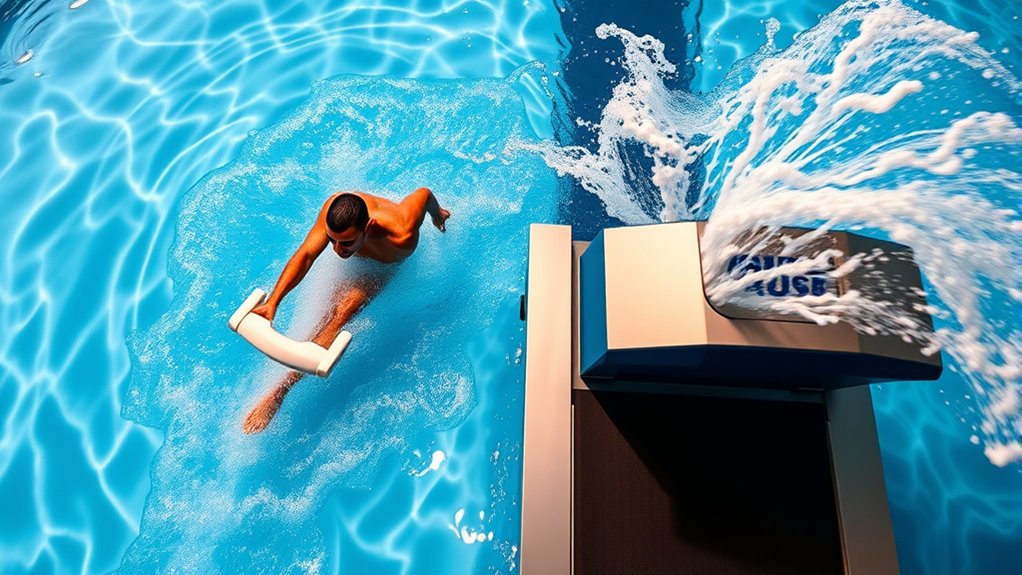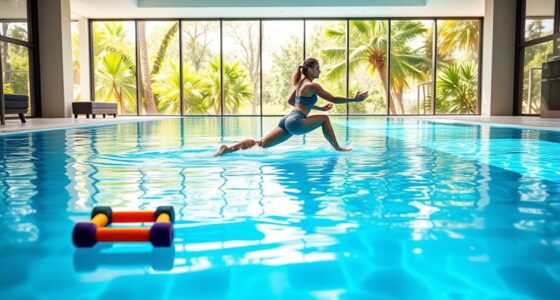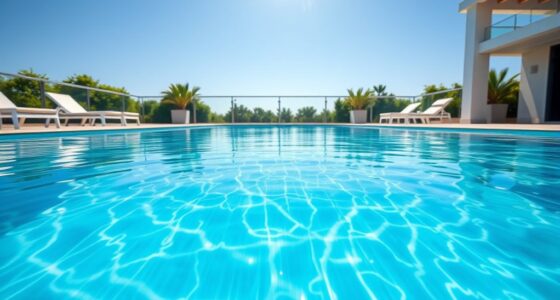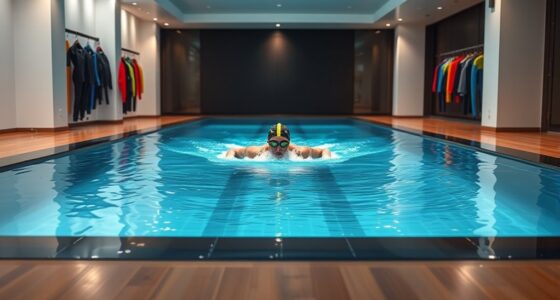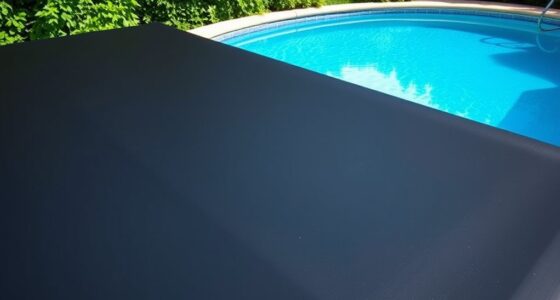If you’re wondering whether water running or an Endless Pool Treadmill burns more calories, it largely depends on workout intensity and duration. Water resistance makes water running challenging and can boost calorie burn at lower speeds, especially during high-intensity intervals. The treadmill offers precise speed and incline adjustments for steady, efficient workouts that can match or surpass water’s calorie expenditure. To discover which option suits your goals best, keep exploring the details ahead.
Key Takeaways
- Water running offers higher resistance due to water density, potentially burning more calories at lower speeds than an Endless Pool Treadmill.
- Endless Pool Treadmill provides precise speed and incline control, enabling consistent intensity for calorie-burning efficiency.
- Water’s natural resistance increases muscular effort, often leading to greater calorie expenditure during water-based workouts.
- Treadmills allow for sustained, steady-state cardio sessions, which can burn similar or more calories over longer durations.
- The overall calorie burn depends on workout duration, intensity, and resistance; water workouts excel in resistance-based calorie expenditure.
Understanding the Basics: Water Running vs. Endless Pool Treadmill
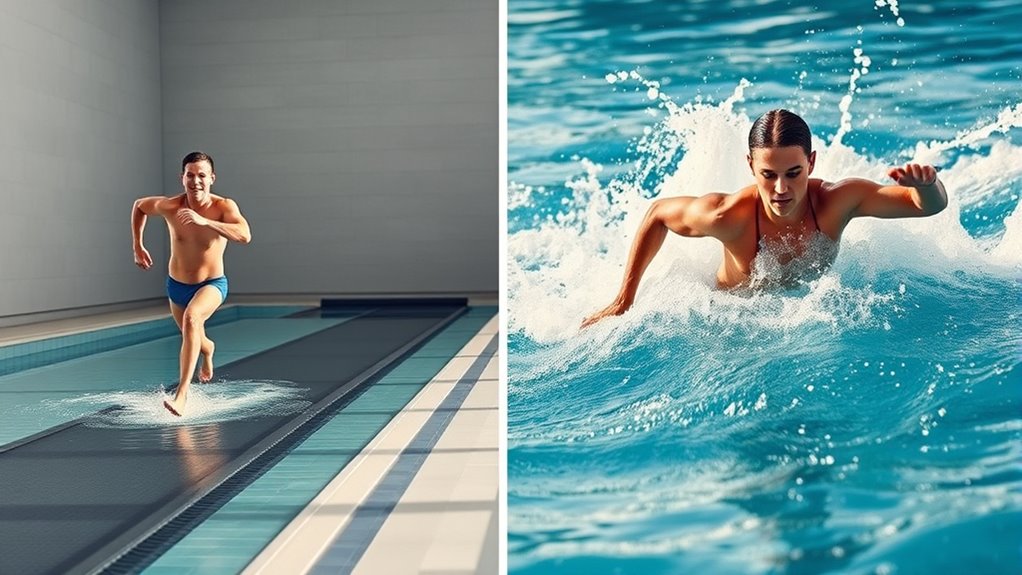
While water running and endless pool treadmills both allow you to train in a controlled aquatic environment, they serve different purposes and function differently. Water running involves jogging or sprinting in place while immersed in water, typically using a buoyancy belt to maintain position. It minimizes joint impact while providing resistance from the water’s density. In contrast, an endless pool treadmill is a motorized system with a moving belt, similar to traditional treadmills but designed for water use. It allows you to run naturally, adjusting speed and intensity easily. While water running emphasizes resistance and low-impact cardio, the endless pool treadmill offers a more familiar running experience with adjustable speed and features that simulate outdoor running. Both methods target fitness but cater to different training needs. Additionally, the level of muscle engagement varies between the two, depending on the resistance and movement patterns involved.
Calorie Burn Comparison: How Each Method Performs

When it comes to burning calories, water running and endless pool treadmills each have their strengths. Water running offers resistance from the water, making each stride more demanding and increasing calorie expenditure. It generally burns more calories at lower speeds because you work against water’s resistance continuously. On the other hand, endless pool treadmills provide a controlled environment where you can easily maintain a consistent pace. They allow for longer, sustained workouts, which can lead to higher total calorie burn over time. If you’re aiming for maximum calorie expenditure in a shorter session, water running might give you a slight edge. However, with steady, longer workouts, endless pool treadmills can match or even surpass water running’s calorie burn, depending on your effort level. Incorporating biodiversity benefits into your exercise routine by choosing outdoor water activities can also enhance your overall well-being and connection to nature.
Impact on Joints and Muscles: Which Is Safer?
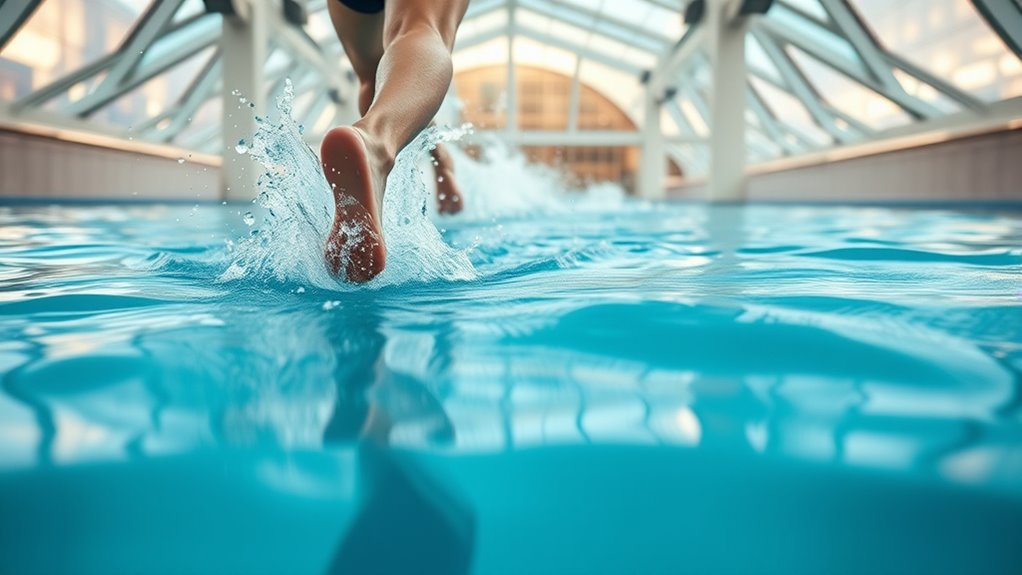
Because water running reduces the impact on your joints and muscles, it’s generally considered safer for those with injuries or chronic pain. Water provides buoyancy, supporting your body and decreasing stress on bones and connective tissues. This minimizes the risk of further injury and soreness. In contrast, treadmill running on land can cause more joint strain, especially if you have existing issues. Water also offers resistance that strengthens muscles without overloading them. To help you compare, here’s a quick view:
| Feature | Water Running | Treadmill Running |
|---|---|---|
| Impact | Low | High |
| Joint Stress | Reduced | Increased |
| Muscle Engagement | Moderate | High |
| Injury Risk | Lower | Higher |
| Suitability for Injuries | Excellent | Limited |
This makes water running a safer choice for sensitive joints and muscles.
Intensity and Resistance: How Water Adds a Challenge

Water’s natural resistance makes every movement more challenging, augmenting the effort required during your workout. You can also adjust the intensity levels to match your fitness goals, whether you want a light session or a tough workout. This combination ensures your exercise stays effective and scalable as you improve. Additionally, incorporating proper maintenance of your equipment can help maintain optimal performance and safety during water-based workouts.
Water’s Natural Resistance
Water naturally offers resistance that challenges your muscles more than air alone. When you move through water, you engage muscles differently, increasing effort without extra impact. This resistance depends on three main factors:
- Speed – The faster you move, the more resistance you encounter.
- Surface Area – Larger limbs or movements create more drag.
- Water Density – Denser water provides greater resistance, making each step harder.
This natural resistance forces you to work harder with less risk of injury. Unlike running in air, water’s resistance engages stabilizer muscles and improves strength. It also encourages controlled, deliberate movements, helping you burn more calories while protecting your joints. Additionally, the contrast ratio of the water’s resistance can be influenced by factors like temperature and water clarity, further affecting workout intensity. Overall, water’s natural resistance amplifies workout intensity without requiring external adjustments.
Adjustable Intensity Levels
Adjustable intensity levels in water-based workouts allow you to tailor the challenge to your fitness level and goals. With both the Endless Pool treadmill and current systems, you can modify water resistance to increase or decrease effort. For the treadmill, adjusting speed and incline helps ramp up intensity, while in a current system, you control resistance by changing the water flow rate. This flexibility guarantees you’re not limited by a fixed challenge; instead, you can gradually progress as your strength improves. Whether you’re recovering from injury or building endurance, these adjustable settings give you control. They also help prevent plateaus by continuously challenging your muscles in different ways. Ultimately, this customization makes water workouts more effective and engaging, aligning perfectly with your evolving fitness needs. Additionally, understanding the refrigeration cycle can help optimize equipment performance and ensure safety during water-based training setups.
Customizing Your Workout: Features and Settings
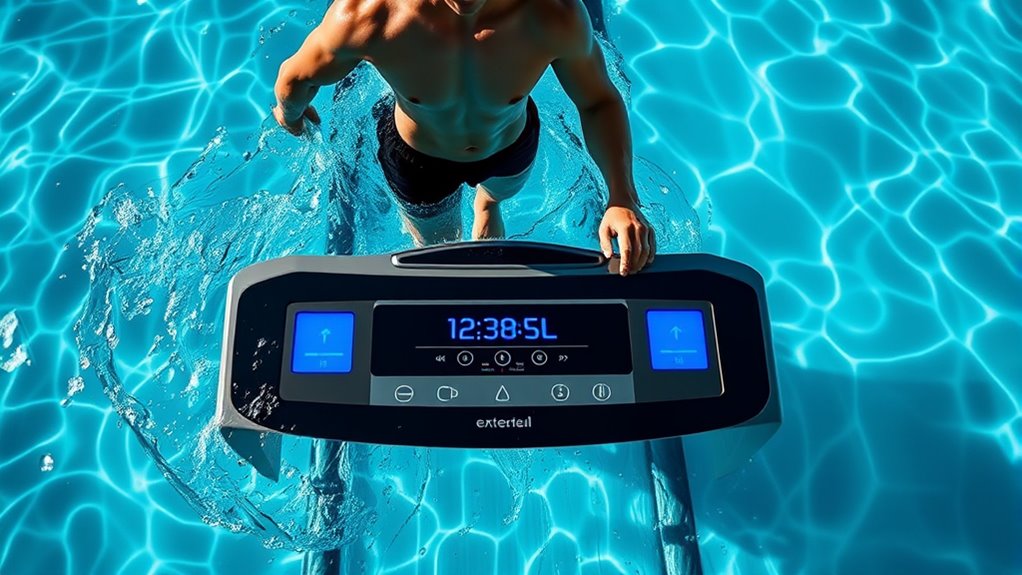
To tailor your workout to your fitness level and goals, both the Endless Pool Treadmill and current models offer a variety of customizable features and settings. These options allow you to control workout intensity and variety. Here are three key features to consider:
Customize your workouts with adjustable speed, programs, and resistance for optimal fitness results.
- Speed Settings – Adjust the treadmill or water current to match your pace, from brisk walks to sprints.
- Program Modes – Choose pre-set workouts or create custom routines to target specific fitness objectives.
- Resistance Levels – Increase or decrease water resistance or treadmill incline to challenge different muscle groups.
- Incorporating multi-functional furniture and designated zones can help create a more efficient workout space, encouraging regular exercise routines.
Practical Considerations: Space, Cost, and Accessibility
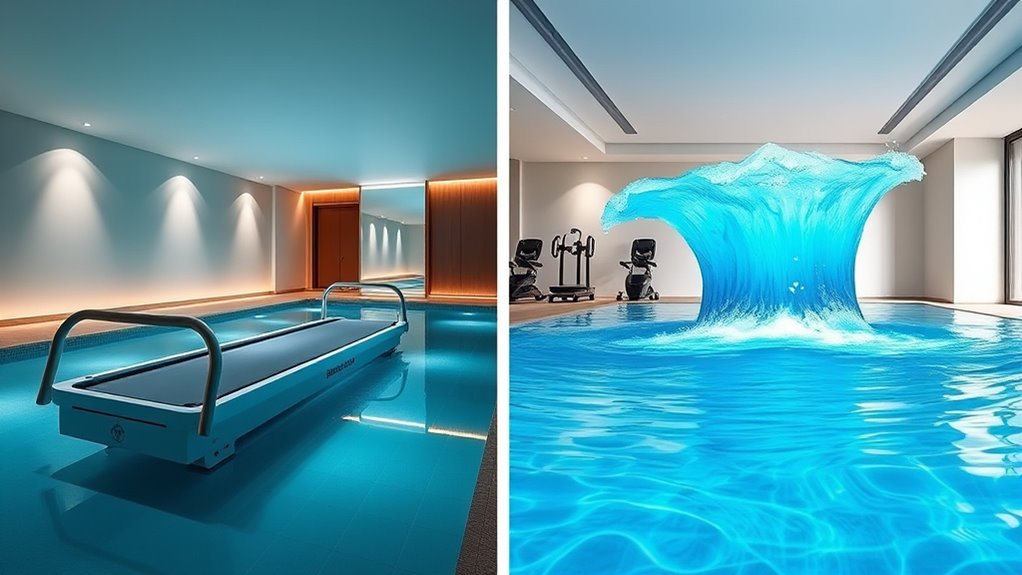
When choosing between an Endless Pool Treadmill and current models, considering space, cost, and accessibility is essential to guarantee they fit seamlessly into your lifestyle. Endless Pool Treadmills typically require a dedicated area, which can be substantial depending on the model, so ensure you have enough room. They also tend to be more expensive upfront, with installation costs adding up. Current models, especially portable ones, often take up less space and are easier to set up in smaller areas. Accessibility is another factor—if you have limited mobility or space constraints, a portable or compact option might work best. Keep in mind that ongoing maintenance and operational costs can vary considerably, so choose a solution that aligns with your budget and available resources. Additionally, understanding the design features of each option can help you select the best fit for your needs.
Training Goals: Which Method Aligns Best With Your Fitness Objectives
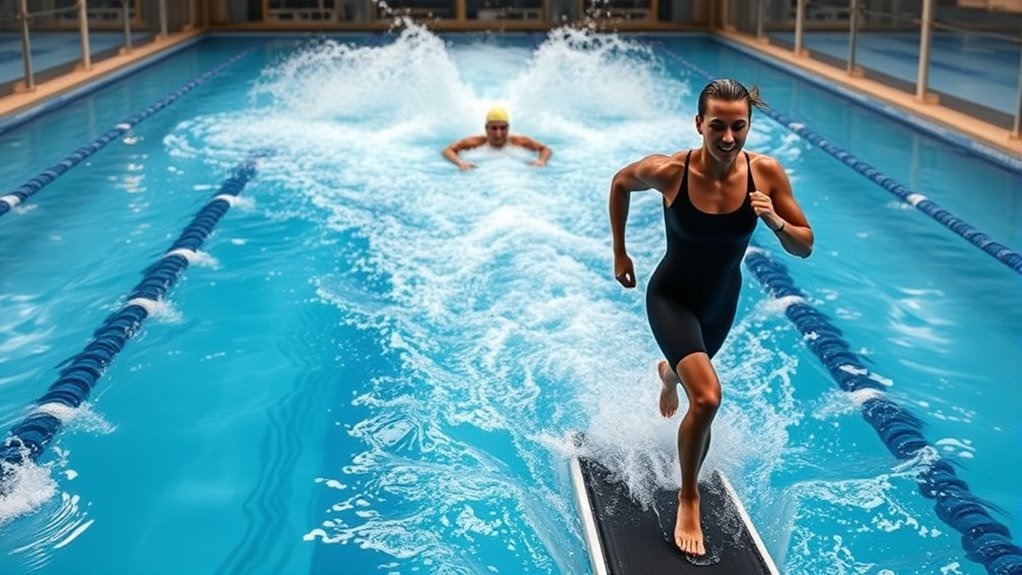
Your fitness goals play a key role in determining whether an Endless Pool Treadmill or a current model best suits your needs. If you aim to improve endurance or burn calories efficiently, the current model’s continuous resistance is ideal. For targeted strength training or low-impact recovery, the treadmill offers controlled, adjustable settings. Consider these points:
- Endless Pool Treadmill is better for structured workouts, speed control, and consistent pacing.
- Current Models excel at high-intensity intervals, simulating open water dynamics.
- Your goals should guide your choice—whether you want steady cardio, interval training, or gentle recovery sessions.
Matching your fitness objectives with the right water resistance method guarantees effective, enjoyable workouts aligned with your progress.
Making the Choice: Factors to Consider for Your Routine

Choosing between an Endless Pool Treadmill and a current model depends on several key factors that shape your workout routine. First, consider space—if your area is limited, an Endless Pool treadmill might be more practical. Next, think about your fitness level and preferences: do you prefer running or walking with adjustable resistance? Your budget also plays a role; Endless Pool treadmills tend to be more expensive upfront. Maintenance and durability are additional factors—water-based systems require proper cleaning and care. Finally, identify your primary goals—if you want high-intensity cardio, the current model might offer more variability. Evaluating these aspects ensures you select the option that best fits your routine, helping you stay consistent and motivated while achieving your fitness objectives. Additionally, understanding the materials needed for candle making can be helpful if you are interested in adding some DIY relaxation elements to your routine.
Frequently Asked Questions
Which Method Is Better for Rehabilitation Purposes?
For rehabilitation, running in water is often better because it reduces impact and minimizes stress on joints, allowing you to recover safely. An endless pool treadmill provides controlled resistance and a consistent environment, which helps rebuild strength and endurance gradually. Both methods are effective, but water running is especially advantageous if you need low-impact therapy, while the treadmill suits those ready for more structured, weight-bearing exercise.
How Does Water Temperature Affect Calorie Burn?
Imagine your body as a fire; warmer water fuels that blaze, making you burn more calories. When water temperature rises, your body works harder to maintain its core temperature, increasing calorie expenditure. Studies show that exercising in water at around 86-92°F boosts calorie burn compared to cooler temps. So, if you want a more intense workout, opt for warmer water—your body will thank you with a higher calorie burn.
Can Beginners Safely Use Water Running Equipment?
Yes, beginners can safely use water running equipment when they follow proper guidelines. You should start slowly, focusing on correct form and gradually increasing intensity. Make sure to warm up beforehand and stay within your comfort zone. It’s also helpful to consult with a fitness professional or physical therapist to guarantee you’re using the equipment safely. With patience and proper technique, water running can be a low-impact, effective workout for beginners.
What Maintenance Is Required for an Endless Pool Treadmill?
You’ll need to regularly clean the treadmill belt and check the lubrication to keep it running smoothly. About 30% of treadmill issues come from poor maintenance, so staying on top of it helps extend your machine’s lifespan. Also, inspect the motor and electrical components monthly to prevent breakdowns. Regularly updating software, if applicable, guarantees peak performance. Proper maintenance keeps your endless pool treadmill reliable and ready for your workouts.
Are There Specific Safety Precautions for Deep Water Running?
Yes, there are specific safety precautions you should follow for deep water running. Always wear a properly fitted flotation belt to stay afloat, and avoid sudden movements that could cause imbalance. Make sure the area is clear of obstacles, and never run alone in deep water. Keep a trained lifeguard or spotter nearby if possible, and listen to your body to prevent overexertion or injury.
Conclusion
Ultimately, choosing between water running and an endless pool treadmill is like selecting your preferred path through a lush, flowing river. Both guide you toward your fitness goals, each offering its gentle current and calm. Trust your instincts to find the one that feels like a invigorating breeze on a warm day, supporting your journey with ease and grace. Whichever you pick, you’ll be dancing along a tranquil stream toward a healthier, stronger you.

